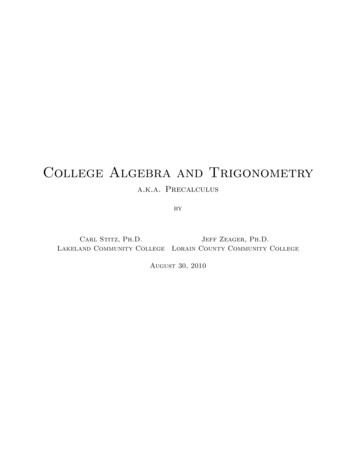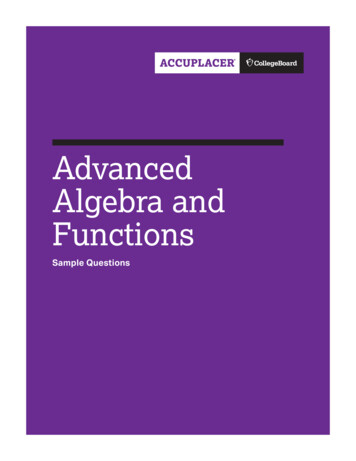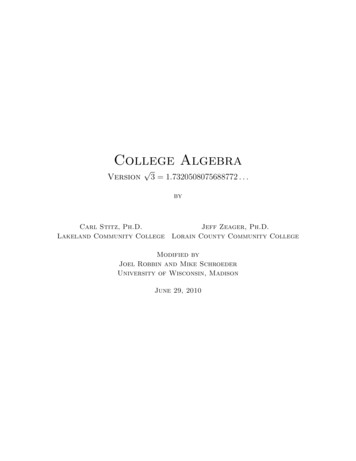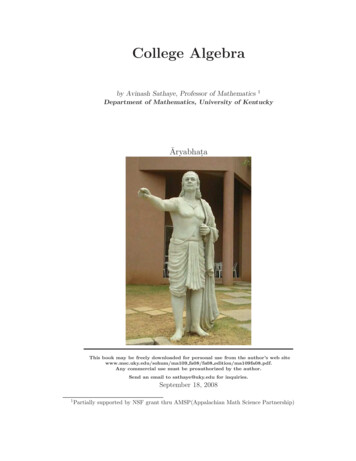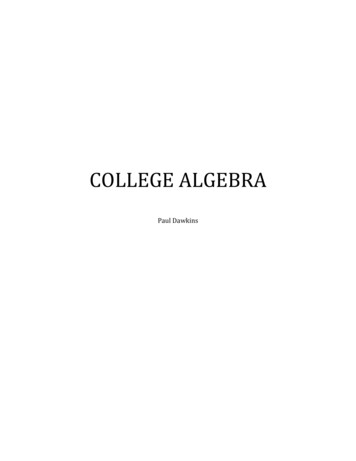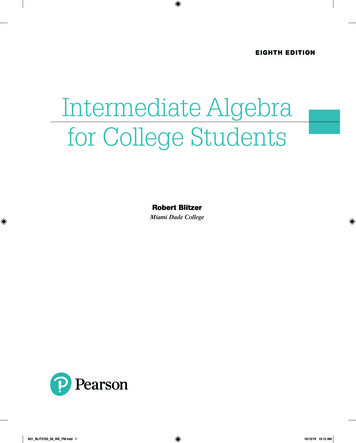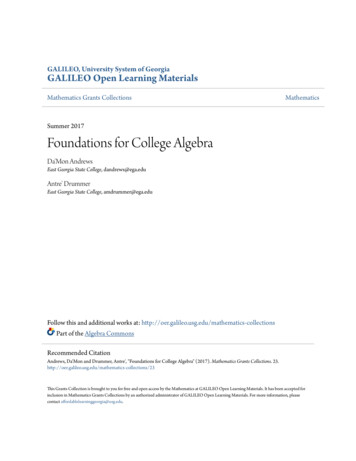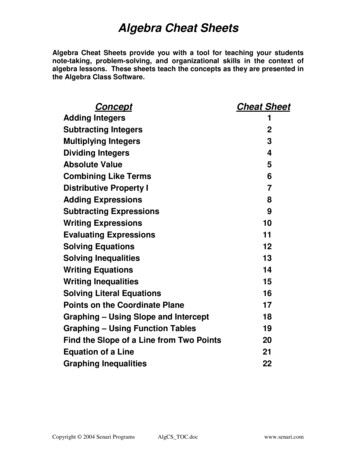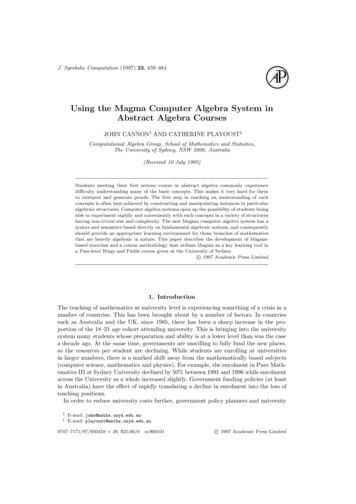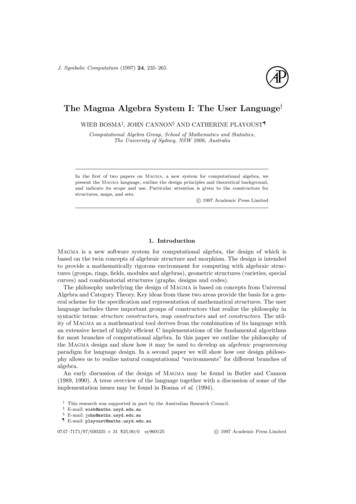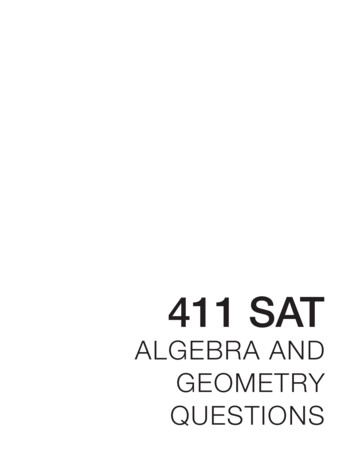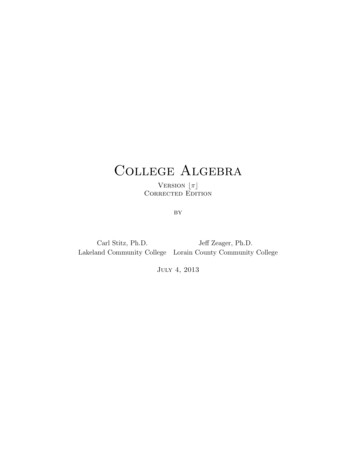
Transcription
College AlgebraVersion bπcCorrected EditionbyCarl Stitz, Ph.D.Lakeland Community CollegeJeff Zeager, Ph.D.Lorain County Community CollegeJuly 4, 2013
iiAcknowledgementsWhile the cover of this textbook lists only two names, the book as it stands today would simplynot exist if not for the tireless work and dedication of several people. First and foremost, we wishto thank our families for their patience and support during the creative process. We would alsolike to thank our students - the sole inspiration for the work. Among our colleagues, we wish tothank Rich Basich, Bill Previts, and Irina Lomonosov, who not only were early adopters of thetextbook, but also contributed materials to the project. Special thanks go to Katie Cimperman,Terry Dykstra, Frank LeMay, and Rich Hagen who provided valuable feedback from the classroom.Thanks also to David Stumpf, Ivana Gorgievska, Jorge Gerszonowicz, Kathryn Arocho, HeatherBubnick, and Florin Muscutariu for their unwaivering support (and sometimes defense) of thebook. From outside the classroom, we wish to thank Don Anthan and Ken White, who designedthe electric circuit applications used in the text, as well as Drs. Wendy Marley and Marcia Ballingerfor the Lorain CCC enrollment data used in the text. The authors are also indebted to the goodfolks at our schools’ bookstores, Gwen Sevtis (Lakeland CC) and Chris Callahan (Lorain CCC),for working with us to get printed copies to the students as inexpensively as possible. We wouldalso like to thank Lakeland folks Jeri Dickinson, Mary Ann Blakeley, Jessica Novak, and CorrieBergeron for their enthusiasm and promotion of the project. The administrations at both schoolshave also been very supportive of the project, so from Lakeland, we wish to thank Dr. Morris W.Beverage, Jr., President, Dr. Fred Law, Provost, Deans Don Anthan and Dr. Steve Oluic, and theBoard of Trustees. From Lorain County Community College, we wish to thank Dr. Roy A. Church,Dr. Karen Wells, and the Board of Trustees. From the Ohio Board of Regents, we wish to thankformer Chancellor Eric Fingerhut, Darlene McCoy, Associate Vice Chancellor of Affordability andEfficiency, and Kelly Bernard. From OhioLINK, we wish to thank Steve Acker, John Magill, andStacy Brannan. We also wish to thank the good folks at WebAssign, most notably Chris Hall,COO, and Joel Hollenbeck (former VP of Sales.) Last, but certainly not least, we wish to thankall the folks who have contacted us over the interwebs, most notably Dimitri Moonen and JoelWordsworth, who gave us great feedback, and Antonio Olivares who helped debug the source code.
Table of ContentsPreface1 Relations and Functions1.1Sets of Real Numbers and the Cartesian Coordinate Plane1.1.1 Sets of Numbers . . . . . . . . . . . . . . . . . . .1.1.2 The Cartesian Coordinate Plane . . . . . . . . . .1.1.3 Distance in the Plane . . . . . . . . . . . . . . . .1.1.4 Exercises . . . . . . . . . . . . . . . . . . . . . . .1.1.5 Answers . . . . . . . . . . . . . . . . . . . . . . . .1.2Relations . . . . . . . . . . . . . . . . . . . . . . . . . . .1.2.1 Graphs of Equations . . . . . . . . . . . . . . . . .1.2.2 Exercises . . . . . . . . . . . . . . . . . . . . . . .1.2.3 Answers . . . . . . . . . . . . . . . . . . . . . . . .1.3Introduction to Functions . . . . . . . . . . . . . . . . . .1.3.1 Exercises . . . . . . . . . . . . . . . . . . . . . . .1.3.2 Answers . . . . . . . . . . . . . . . . . . . . . . . .1.4Function Notation . . . . . . . . . . . . . . . . . . . . . .1.4.1 Modeling with Functions . . . . . . . . . . . . . .1.4.2 Exercises . . . . . . . . . . . . . . . . . . . . . . .1.4.3 Answers . . . . . . . . . . . . . . . . . . . . . . . .1.5Function Arithmetic . . . . . . . . . . . . . . . . . . . . .1.5.1 Exercises . . . . . . . . . . . . . . . . . . . . . . .1.5.2 Answers . . . . . . . . . . . . . . . . . . . . . . . .1.6Graphs of Functions . . . . . . . . . . . . . . . . . . . . .1.6.1 General Function Behavior . . . . . . . . . . . . .1.6.2 Exercises . . . . . . . . . . . . . . . . . . . . . . .1.6.3 Answers . . . . . . . . . . . . . . . . . . . . . . . .1.7Transformations . . . . . . . . . . . . . . . . . . . . . . . .1.7.1 Exercises . . . . . . . . . . . . . . . . . . . . . . .1.7.2 Answers . . . . . . . . . . . . . . . . . . . . . . . 114120140144
ivTable of Contents2 Linear and Quadratic Functions2.1Linear Functions . . . . . . . . . . . . . . . . .2.1.1 Exercises . . . . . . . . . . . . . . . . .2.1.2 Answers . . . . . . . . . . . . . . . . . .2.2Absolute Value Functions . . . . . . . . . . . .2.2.1 Exercises . . . . . . . . . . . . . . . . .2.2.2 Answers . . . . . . . . . . . . . . . . . .2.3Quadratic Functions . . . . . . . . . . . . . . .2.3.1 Exercises . . . . . . . . . . . . . . . . .2.3.2 Answers . . . . . . . . . . . . . . . . . .2.4Inequalities with Absolute Value and Quadratic2.4.1 Exercises . . . . . . . . . . . . . . . . .2.4.2 Answers . . . . . . . . . . . . . . . . . .2.5Regression . . . . . . . . . . . . . . . . . . . . .2.5.1 Exercises . . . . . . . . . . . . . . . . .2.5.2 Answers . . . . . . . . . . . . . . . . . .1511511631691731831841882002032082202222252302333 Polynomial Functions3.1Graphs of Polynomials . . . . . . . . . . . . . . . . . . . . . . .3.1.1 Exercises . . . . . . . . . . . . . . . . . . . . . . . . . .3.1.2 Answers . . . . . . . . . . . . . . . . . . . . . . . . . . .3.2The Factor Theorem and the Remainder Theorem . . . . . . .3.2.1 Exercises . . . . . . . . . . . . . . . . . . . . . . . . . .3.2.2 Answers . . . . . . . . . . . . . . . . . . . . . . . . . . .3.3Real Zeros of Polynomials . . . . . . . . . . . . . . . . . . . . .3.3.1 For Those Wishing to use a Graphing Calculator . . . .3.3.2 For Those Wishing NOT to use a Graphing Calculator3.3.3 Exercises . . . . . . . . . . . . . . . . . . . . . . . . . .3.3.4 Answers . . . . . . . . . . . . . . . . . . . . . . . . . . .3.4Complex Zeros and the Fundamental Theorem of Algebra . . .3.4.1 Exercises . . . . . . . . . . . . . . . . . . . . . . . . . .3.4.2 Answers . . . . . . . . . . . . . . . . . . . . . . . . . . . 301. 314. 316. 320. 333. 335. 342. 350. 3534 Rational Functions4.1Introduction to Rational Functions . .4.1.1 Exercises . . . . . . . . . . . .4.1.2 Answers . . . . . . . . . . . . .4.2Graphs of Rational Functions . . . . .4.2.1 Exercises . . . . . . . . . . . .4.2.2 Answers . . . . . . . . . . . . .4.3Rational Inequalities and Applications4.3.1 Variation . . . . . . . . . . . .4.3.2 Exercises . . . . . . . . . . . . . . . . . . . . . . . . . . . . . . . . . . . . . . . . . . . . . . . . . . . . . . . . .Functions. . . . . . . . . . . . . . . . . . . . . . . . . .
Table of Contents4.3.3vAnswers . . . . . . . . . . . . . . . . . . . . . . . . . . . . . . . . . . . . . . 3565 Further Topics in Functions5.1Function Composition . .5.1.1 Exercises . . . . .5.1.2 Answers . . . . . .5.2Inverse Functions . . . . .5.2.1 Exercises . . . . .5.2.2 Answers . . . . . .5.3Other Algebraic Functions5.3.1 Exercises . . . . .5.3.2 Answers . . . . . .3593593693723783943963974074116 Exponential and Logarithmic Functions6.1Introduction to Exponential and Logarithmic Functions6.1.1 Exercises . . . . . . . . . . . . . . . . . . . . . .6.1.2 Answers . . . . . . . . . . . . . . . . . . . . . . .6.2Properties of Logarithms . . . . . . . . . . . . . . . . . .6.2.1 Exercises . . . . . . . . . . . . . . . . . . . . . .6.2.2 Answers . . . . . . . . . . . . . . . . . . . . . . .6.3Exponential Equations and Inequalities . . . . . . . . . .6.3.1 Exercises . . . . . . . . . . . . . . . . . . . . . .6.3.2 Answers . . . . . . . . . . . . . . . . . . . . . . .6.4Logarithmic Equations and Inequalities . . . . . . . . .6.4.1 Exercises . . . . . . . . . . . . . . . . . . . . . .6.4.2 Answers . . . . . . . . . . . . . . . . . . . . . . .6.5Applications of Exponential and Logarithmic Functions6.5.1 Applications of Exponential Functions . . . . . .6.5.2 Applications of Logarithms . . . . . . . . . . . .6.5.3 Exercises . . . . . . . . . . . . . . . . . . . . . .6.5.4 Answers . . . . . . . . . . . . . . . . . . . . . . 824907 Hooked on Conics7.1Introduction to Conics7.2Circles . . . . . . . . .7.2.1 Exercises . . .7.2.2 Answers . . . .7.3Parabolas . . . . . . .7.3.1 Exercises . . .7.3.2 Answers . . . .7.4Ellipses . . . . . . . .7.4.1 Exercises . . .7.4.2 Answers . . . .495495498502503505512513516525527.
viTable of Contents7.5Hyperbolas . . . . . . . . . . . . . . . . . . . . . . . . . . . . . . . . . . . . . . . . 5317.5.1 Exercises . . . . . . . . . . . . . . . . . . . . . . . . . . . . . . . . . . . . . 5417.5.2 Answers . . . . . . . . . . . . . . . . . . . . . . . . . . . . . . . . . . . . . . 5448 Systems of Equations and Matrices8.1Systems of Linear Equations: Gaussian Elimination .8.1.1 Exercises . . . . . . . . . . . . . . . . . . . .8.1.2 Answers . . . . . . . . . . . . . . . . . . . . .8.2Systems of Linear Equations: Augmented Matrices .8.2.1 Exercises . . . . . . . . . . . . . . . . . . . .8.2.2 Answers . . . . . . . . . . . . . . . . . . . . .8.3Matrix Arithmetic . . . . . . . . . . . . . . . . . . .8.3.1 Exercises . . . . . . . . . . . . . . . . . . . .8.3.2 Answers . . . . . . . . . . . . . . . . . . . . .8.4Systems of Linear Equations: Matrix Inverses . . . .8.4.1 Exercises . . . . . . . . . . . . . . . . . . . .8.4.2 Answers . . . . . . . . . . . . . . . . . . . . .8.5Determinants and Cramer’s Rule . . . . . . . . . . .8.5.1 Definition and Properties of the Determinant8.5.2 Cramer’s Rule and Matrix Adjoints . . . . .8.5.3 Exercises . . . . . . . . . . . . . . . . . . . .8.5.4 Answers . . . . . . . . . . . . . . . . . . . . .8.6Partial Fraction Decomposition . . . . . . . . . . . .8.6.1 Exercises . . . . . . . . . . . . . . . . . . . .8.6.2 Answers . . . . . . . . . . . . . . . . . . . . .8.7Systems of Non-Linear Equations and Inequalities . .8.7.1 Exercises . . . . . . . . . . . . . . . . . . . .8.7.2 Answers . . . . . . . . . . . . . . . . . . . . .9 Sequences and the Binomial Theorem9.1Sequences . . . . . . . . . . . . . . .9.1.1 Exercises . . . . . . . . . . .9.1.2 Answers . . . . . . . . . . . .9.2Summation Notation . . . . . . . . .9.2.1 Exercises . . . . . . . . . . .9.2.2 Answers . . . . . . . . . . . .9.3Mathematical Induction . . . . . . .9.3.1 Exercises . . . . . . . . . . .9.3.2 Selected Answers . . . . . . .9.4The Binomial Theorem . . . . . . . .9.4.1 Exercises . . . . . . . . . . .9.4.2 Answers . . . . . . . . . . . 23627628635636637646648.651. 651. 658. 660. 661. 670. 672. 673. 678. 679. 681. 691. 692
PrefaceThank you for your interest in our book, but more importantly, thank you for taking the time toread the Preface. I always read the Prefaces of the textbooks which I use in my classes becauseI believe it is in the Preface where I begin to understand the authors - who they are, what theirmotivation for writing the book was, and what they hope the reader will get out of reading thetext. Pedagogical issues such as content organization and how professors and students should bestuse a book can usually be gleaned out of its Table of Contents, but the reasons behind the choicesauthors make should be shared in the Preface. Also, I feel that the Preface o
textbook, but also contributed materials to the project. Special thanks go to Katie Cimperman, Terry Dykstra, Frank LeMay, and Rich Hagen who provided valuable feedback from the classroom. Thanks also to David Stumpf, Ivana Gorgievska, Jorge Gerszonowicz, Kathryn Arocho, Heather Bubnick, and Florin Muscutariu for their unwaivering support (and sometimes defense) of the book. From outside the .
